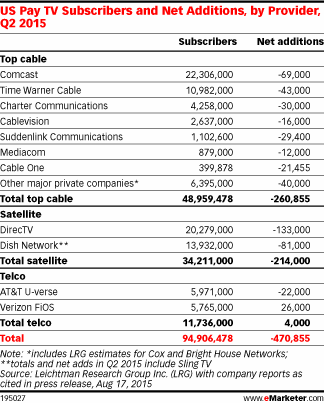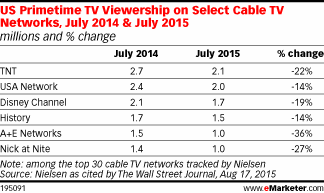![]() New studies show pay TV providers saw a large and significant decline in the number of subscribers in the second quarter of this year, losing more than 470,000 subscribers – almost a half million – during the quarter. It was their worst quarterly performance ever and indicates a growing, troubling trend.
New studies show pay TV providers saw a large and significant decline in the number of subscribers in the second quarter of this year, losing more than 470,000 subscribers – almost a half million – during the quarter. It was their worst quarterly performance ever and indicates a growing, troubling trend.
See more on this new research and see why cable content providers aren’t faring much better…
In a study by Leichtman Research Group of the 13 largest cable, satellite, and telco pay TV providers, the data suggests a strong migration away from traditional pay TV providers. These top 13 providers represent almost 95% of the pay TV market and while the subscriber numbers have been declining, this was a significant downturn as compared to recent quarterly figures.
The study was reported on by eMarketer who noted that there are a total of 94.9 million pay TV subscribers. There were 7 major cable companies, two major satellite companies, and two major teleco companies tracked. There was also a provision for “Other” major private cable companies.
Cable’s Losses Stabilized
Cable companies, with a total of 49 million subscribers, saw their total decline by more than a quarter of a million – or 260,855 subscribers. This was actually an improvement over the same quarter the previous year when cable companies themselves lost 510,000 subscribers.
The satellite providers have a collective total of more than 34 million subscribers – much less than cable. But satellite providers lost 214,000 subscribers in total with DirecTV itself shedding 133,000. As big as that number is, eMarketer says it is actually a smaller loss than in other quarters for DirecTV.
Only Segment to Increase
Only the telco (telephone companies) category saw an increase in subscribers…although a very small one, gaining a total of 4,000 subscribers with a total universe of 11.7 million. The two providers tracked in this segment are AT&T U-verse and Verizon FiOS. Ironically, it looks as though Verizon sucked up all of the subscribers lost by AT&T – 22,000 lost – and added more with a total Verizon gain of 26,000 subscribers.
The big content creators, in the form of cable networks, are not faring much better. According to eMarketer, a study by Nielsen (and reported in the Wall Street Journal) of the top 30 cable networks shows changing trends as well. Nielsen tracked 30 major cable networks during the month of July, and eMarketer showed the results of the top 7 networks in terms of viewership.
Cable Networks Struggle Also
In the past, the big cable networks were quite successful in getting people hooked on the latest reality show – sucking viewers away from the big network channels. But in July, cable networks struggled as viewers turned to alternatives for programming.
In July, TNT had the largest primetime audience ratings with an average of 2.1 million viewers. But this number is down an alarming 22% as compared to the 2.7 million average viewers in July 2014.
Why Is This Happening?
All of the major cable networks showed declines, with A&E Networks seeing a huge 36% decline to just 1 million average primetime viewers. But none of this group is feeling good about their numbers as all had double-digit declines.
The Wall Street Journal article attributes these results to the new cable network shows flopping – summer is when they typically roll out new programming to hook viewers. But also, the Journal notes viewers are opting for more digital video devices and video-on-demand options.
And though the WSJ doesn’t mention it directly, we’d hazard a guess that online, on-demand content is one of – if not the – prime culprit for these results.





Leave a Reply